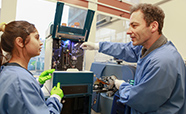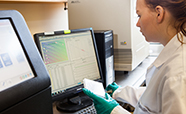The Department of Biochemistry is well equipped, with almost all experimentation being able to be performed in-house, including X-ray crystallography. High resolution electron microscopy and fluorescence activated cell sorting are available on campus, and we have regular access to the Australian synchrotron. The Department of Biochemistry is also home to two service units, the Centre for Protein Research and the Otago Genomics Facility.

Centre for Protein Research

Otago Genomics Facility

Databases and Software
Specialist equipment
Cell imaging
The Cytation 5 and Cytell are digital imaging platforms with the ability to image a variety of samples in flasks, plates, dishes or on slides at 4X, 10X, and 20X.
Nucleotide sequencing
The Illumina MiSeq sequencer is part of the OGBF. Their staff are available to help develop new methodologies and workflows.
RT-PCR
The Department has several Roche Real Time PCR machines and robots that can be used to set up PCR reactions in 96- and 384-well plates.
Fluorescent microscopy
The Department's inverted fluorescence microscope is a Nikon Ti2-A. This machine has both brightfield and fluorescence capabilities; boasting an expanded filter cube set and a large range of objectives (4x – 60x). It allows for the imaging of living cells (in flasks with media), along with fixed cells or tissue on slides.
The upright fluorescence microscope is an Olympus BX51, and has a more limited range of objectives and filters but is perfect for imaging of fixed cells or tissue on slides.
Molecular interaction analyses
Isothermal titration calorimetry (ITC) is widely viewed as the 'gold-standard' for determining binding affinities of protein-ligand interactions (best suited to interactions with moderate to high affinities (10 nM to 100 μM Kd). Our Microcal VP-ITC microcalorimeter requires relatively large amounts of protein (sample chamber is ~1.8mL) and is low-to-medium throughput, however, with careful experimental set-up, can provide a wealth of thermodynamic data.
Surface Plasmon Resonance (SPR), used for binding constant determination and thermodynamic analysis, is provided via a Biacore X100 from GE.
Circular dichroism
We have two CD spectrophotometers. Their primary use is to analyse the secondary structure of macromolecules, particularly proteins, and can be used to monitor changes in secondary structure in response to changes in the environment, e.g. temperature or pH.
X-ray crystallography
Our home source X-rays are produced by a Rigaku 007HF rotating anode (both copper and chromium anodes) with VariMax optics and an R-axis IV++ detector. Cryo-cooling is provided by an X-stream 2000 system. We also have regular access to the Australian synchrotron X-ray source in Melbourne.
We have a Mosquito robot, which is mostly used for setting up crystal plates, although it is useful generally for pipetting small volumes (100nL up to 1.2µL) into 96 or 384 well plates.
We also have a Rock Imager crystal hotel, which allows monitoring of crystallography experiments from anywhere in the university.
qPCR and HRM assays
There are two Bio-Rad Real-Time PCR (qPCR) Detection Systems, the CFX96 Touch™ (96 well) and MJ Mini Mini Opticom (48-well), available for departmental use. These real-time PCR instruments have advanced optical technology (five colours and one FRET channel) and thermal gradient control allowing for either singleplex or multiplex reactions. These machines are designed for both qPCR and High-Resolution Melt (HRM) assays and are compatible with a number of standard reporter dyes (e.g. SYBER, FAM, Texas Red)
Mass spectrometry
The Centre for Protein Research runs three different mass spectrometry systems, a TripleTOF 5600+, an LTQ-Orbitrap, and an ABI 4800 MALDI tandem time of flight.